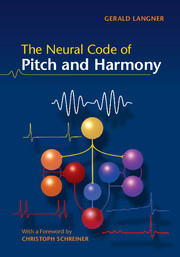Book contents
- Frontmatter
- Contents
- Preface
- Foreword
- 1 Historical aspects of harmony
- 2 Sound and periodicity
- 3 The discovery of the missing fundamental
- 4 The pitch puzzle
- 5 The auditory time constant
- 6 Pathways of hearing
- 7 Periodicity coding in the brainstem
- 8 Periodicity coding in the midbrain
- 9 Theories of periodicity coding
- 10 Periodotopy
- 11 The neural code of harmony
- 12 The oscillating brain
- References
- Index
2 - Sound and periodicity
Published online by Cambridge University Press: 05 May 2015
- Frontmatter
- Contents
- Preface
- Foreword
- 1 Historical aspects of harmony
- 2 Sound and periodicity
- 3 The discovery of the missing fundamental
- 4 The pitch puzzle
- 5 The auditory time constant
- 6 Pathways of hearing
- 7 Periodicity coding in the brainstem
- 8 Periodicity coding in the midbrain
- 9 Theories of periodicity coding
- 10 Periodotopy
- 11 The neural code of harmony
- 12 The oscillating brain
- References
- Index
Summary
‘A musical sound is produced by pulses or waves which follow each other at regular intervals with sufficient rapidity of succession.’
(John Tyndall, ‘Sound’, Lecture II, Longmann & Co., 1893)Sound is movement
The Ancient Greeks had only a limited understanding of the physical nature of sound, but they did realize that sound is produced by the movement of an object or of parts of an object. They also knew that the pitch of the sound is related to certain physical attributes of the sound-emitting object, such as its weight or its length. Archytas of Tarentum, in the fourth century BC, may have been the first to make the connection between the vibration frequency of an object and the pitch of the resulting sound. Aristotle (384 – 322 BC) noticed the phenomenon of resonance in strings, and even observed that the tone of a vibrating string contains the octave of its fundamental pitch. Yet for thousands of years the mechanisms behind the creation of harmonic sounds, i.e. the periodic oscillations of strings or other vibrating structures, remained a mystery.
In addition, very little was known of the means by which sound propagates, how it is transmitted through the air to reach our ears. Aristotle compared echoes with balls bouncing back from a wall and correctly concluded that sound must travel by means of waves. Almost 2000 years later, Leonardoda Vinci (1452 – 1519) also concluded that sound propagates just like waves in water – he compared acoustical echoes to the reflection of waves on the banks of a pond.
In the seventeenth century, the British scientist Robert Boyle (1626 – 1691) convincingly demonstrated for the first time that sound needs a medium, such as air, to propagate. From his experiments it became clear that the vibration of a membrane, a tube or a string elicits corresponding oscillations of adjacent molecules in the air.
- Type
- Chapter
- Information
- The Neural Code of Pitch and Harmony , pp. 11 - 23Publisher: Cambridge University PressPrint publication year: 2015



